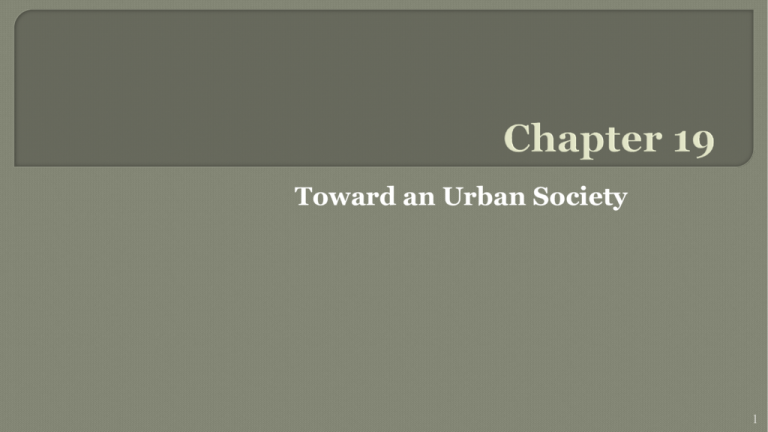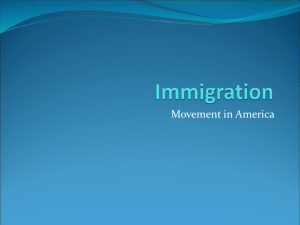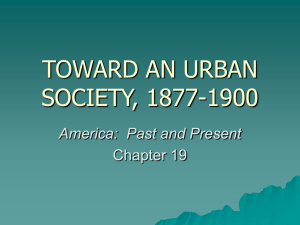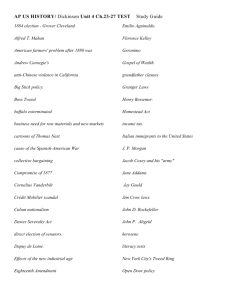
Toward an Urban Society
1
By the early 1900s immigrant populations were overwhelming
American cities
More Poles in Chicago than in Warsaw, Poland!
More Irish in New York than in Dublin, Ireland!
Many immigrants often lived in neighborhoods with others
who shared their background
This helped them adapt to the new culture
Many African Americans moved North to cities like Detroit
and Chicago
2
3
4
Row houses became very popular
Working class families were moving out
of the city
Dumbbell tenements were oddly
shaped in include an air shaft
• Unfortunately people began
to use them as a garbage
disposal
5
6
WATER/SANITATION
TRANSPORTATION
PROBLEM: People can’t get to
work
Streetcars
Cable cars
Subways
Many tenements did not have fresh water
Diseases were spread
• Horse manure in the streets
• sewage in the gutters
• foul smoke from factories
7
Lack
of water
Wooden
1853
dwellings
– first paid fire
dept.
1874
– first auto fire
sprinkler
1844
– first organized
police force
Chicago Fire 1871
8
12
© 2011, The McGraw-Hill Companies,
Inc. All Rights Reserved.
Total Immigration, 1861-1900
13
Baltimore 1850
Baltimore 1910
The Diverse Immigrant Populations
Lived in ghettos together
Why did this make it easier to
adjust?
Importance of Ethnic Ties
Felt more comfortable
Continued traditions
Advanced in society
15
Assimilation Encouraged
Mainly English
Stores sold American food and clothing
Immigration Restriction League
Screen immigrants through literacy tests
“desirable” and “undesirable”
What was the benefit to so much immigration?
16
© 2011, The McGraw-Hill Companies, Inc. All Rights Reserved.
17
“Immigration Under Attack,” 1903
18
(New York Public Library.
Astor, Lenox and Tilden Foundations)
About a one week trip
Immigrants stayed in steerage
Checked for diseases
• This could take up to 5 hours!
Needed to:
• Pass a test
• Able to work
• $25
From 1892-1943, more than 16
million immigrants passed
through!
19
20
21
22
Chinese
and others arrived off
the coast of San Francisco at
Angel Island
Between
1910-1940 50,000
Chinese entered through Angel.
VERY
long admission
process
Kept
like prisoners
23
24
• Built to represent something different than a city
• Libraries, parks, theaters
• Who supported the construction of these projects?
The Mall in Central Park, 1902 (Library of Congress)
25
What were the various positives and negatives of
Tweed and other bosses?
Often were vehicles for making money
“Boss” Tweed
VIDEO:
BOSS TWEED
26
End
of Reconstruction marks shift of attention to
new concerns
Population
growth
• 1877: 47 million
• 1900: 76 million
• 1900: population more diverse
Urbanization,
industrialization changing all
aspects of American life
27
28
Victorian
morality dictates dress, manners
Protestant
religious values strong
Mugwumps
Women’s
Christian Temperance Union (WCTU)
29
Domestic
leisure: card, parlor, yard games
Sentimental
ballads, ragtime popular
Entertainment
•
•
outside home
Circus immensely popular
Baseball, football, basketball
Street
lights, streetcars make evening a time for
entertainment and pleasure
30
"New women”: Self-supporting careers
• How were they viewed?
Demand an end to gender discrimination
Speak openly about once-forbidden topics
• Divorce, equal pay, etc..
Susan B. Anthony helped to create the
National American Women’s Suffrage
Association (NAWSA)
31
Trend
is toward universal education: By 1900, 31
states and territories had compulsory education
laws
Purpose
of public education was to train people
for life and work in industrial society
1896:
Plessy v. Ferguson allows “separate but equal”
schools
• Challenges under the 14th amendment; loses in a 7-1 decision
32
What
societal issues were created following the
ruling in Plessy v. Ferguson?
What
is the obvious oversight in this court
decision?
https://www.youtube.com/watch?v=P4Wyb7f-iNc
33
34
Booker T. Washington vs. W.E.B. Du Bois
National Association for the Advancement
of Colored People (NAACP)
“Is it possible and probable that nine millions
of men can make effective progress in economic lines if
they are deprived of political rights, made a servile caste,
and allowed only the most meager chance for developing
their exceptional men?”
W. E. B. Du Bois
35
Most mainstream or old line Protestant
churches struggle to address plight of
urban poor
Jane Addams: Reformer,
Catholicism thrives, founds
studies social ills, founds Hull
schools and parishes
House in Chicago in 1889
SOCIAL GOSPEL is preached
(vs. SOCIAL DARWINISM)
Florence Kelley joined in
the movement to popularize
Settlement Houses
founded to provide assistance to
poor and new immigrants
Provided aid and education
36
Political Realignments of the 1890s
© 2011, The McGraw-Hill Companies, Inc. All Rights Reserved.
37
Politics
was a major fascination of the late nineteenth
century
White
males made up bulk of electorate
• Women allowed to vote in national elections only in
Wyoming, Utah, Idaho, Colorado
• Black men denied vote by poll tax, literacy tests
Grandfather Clause
38
Democrats emphasize state’s rights and limited government
Republicans see government as agent to promote moral progress and material wealth
One-party control of both Congress and White House rare
“Doubtful” states
• What were these?
Federal influence wanes, state control rises
39
State
government commissions investigate, regulate
railroads, factories
Munn
v. Illinois (1877) upholds constitutionality of state
investigations
Wabash
case (1886) prompts establishment of Interstate
Commerce Commission (ICC)
ICC
prototype for modern regulatory agencies
40
Presidency
Later
•
•
•
•
hits nadir under Johnson
presidents reassert executive power
Hayes ended military Reconstruction
Garfield asserted leadership of his party
Arthur strengthened navy, civil service reform
Cleveland used veto to curtail federal activities, called for
low tariffs
41
© 2011, The McGraw-Hill Companies, Inc. All Rights Reserved.
42
43
44
45
Discontented
farmers of West and South provide
base of support
The
National Farmers' Alliance and Industrial
Union the result
46
Worldwide
agricultural economy causes great fluctuations
in supply and demand
Farmers’
•
•
•
complaints:
Lower prices for crops (although purchasing power rising)
Rising railroad rates (rates actually declining)
Onerous mortgages (loans permit production expansion)
Conditions
General
of farmers vary by region
feeling of depression, resentment
47
48
1875:
Southern Alliance begins
Alliance
movement segregated, Colored Farmer’s
National Alliance
• Destroyed after leaders lynched in 1891
1889:
Regional Alliances merge into National Farmer’s
Alliance
49
System
of government warehouses to hold crops for
higher prices
Free coinage of silver
Low tariffs
Federal income tax
Direct election of Senators
Regulation of railroads
50
Southern
Alliance splits from Democrats to form
Populist party
Southern
Populists recruit African Americans,
give them influential positions
1892:
Populist presidential candidate James Weaver
draws over one million votes
• Loses South to violence and intimidation by Southern Democrats
• Loses urban areas
51
52








